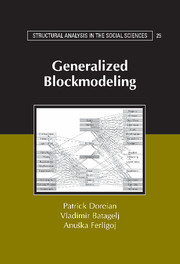Book contents
- Frontmatter
- Contents
- Preface
- 1 Social Networks and Blockmodels
- 2 Network Data Sets
- 3 Mathematical Prelude
- 4 Relations and Graphs for Network Analysis
- 5 Clustering Approaches
- 6 Optimizational Approach to Conventional Blockmodeling
- 7 Foundations for Generalized Blockmodeling
- 8 Blockmodeling Two-Mode Network Data
- 9 Semirings and Lattices
- 10 Balance Theory and Blockmodeling Signed Networks
- 11 Symmetric–Acyclic Blockmodels
- 12 Extending Generalized Blockmodeling
- Bibliography
- Author Index
- Subject Index
- Titles in the series
1 - Social Networks and Blockmodels
Published online by Cambridge University Press: 13 January 2010
- Frontmatter
- Contents
- Preface
- 1 Social Networks and Blockmodels
- 2 Network Data Sets
- 3 Mathematical Prelude
- 4 Relations and Graphs for Network Analysis
- 5 Clustering Approaches
- 6 Optimizational Approach to Conventional Blockmodeling
- 7 Foundations for Generalized Blockmodeling
- 8 Blockmodeling Two-Mode Network Data
- 9 Semirings and Lattices
- 10 Balance Theory and Blockmodeling Signed Networks
- 11 Symmetric–Acyclic Blockmodels
- 12 Extending Generalized Blockmodeling
- Bibliography
- Author Index
- Subject Index
- Titles in the series
Summary
These are exciting times for social network analysts. As Hummon and Carley (1993) observed, their area has emerged as an integrated social scientific specialty. Some (e.g., Berkowitz 1982:150 and Rogers 1987:308) have declared that social network analysis is revolutionary for the social sciences. Doreian (1995) argued that this is a premature judgment. It was not clear then – nor is it clear now – that there is a network paradigm in the sense of “a set of shared methods, standards, modes of explanation, or theories or a body of shared knowledge” (Cohen 1985:26) adhered to by all network analysts. In part, this can be attributed to the field's having its historical origins in a wide variety of disciplines. Fields such as anthropology, business administration, communication, history, mathematics, political science, and sociology have scholars whose research, at least in part, includes network analytic ideas. Even though some network analysts view social networks as their field, they do not share all of the features of a specialty listed by Cohen. However, network analysts do agree that social networks are important – even crucial – and that network-based explanations of social phenomena have a distinctive character. Wellman (1988) is most persuasive in arguing that network accounts of social phenomena, in addition to being distinctive, are also more potent. Even so, network analysts differ on some of the specifics. In our view, this is a positive feature of the specialty given a commitment to using network tools of some sort.
Certainly the trappings of a coherent social science specialty are in place: The International Association of Social Network Analysts (INSNA) was formed in 1976.
- Type
- Chapter
- Information
- Generalized Blockmodeling , pp. 1 - 29Publisher: Cambridge University PressPrint publication year: 2004
- 1
- Cited by



